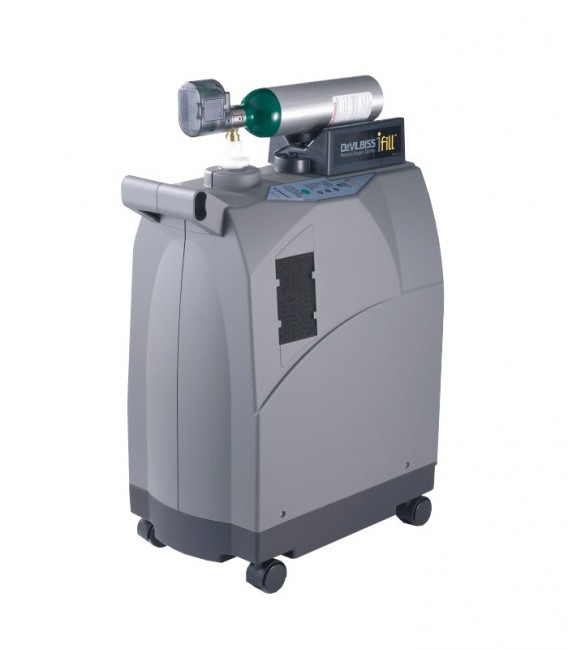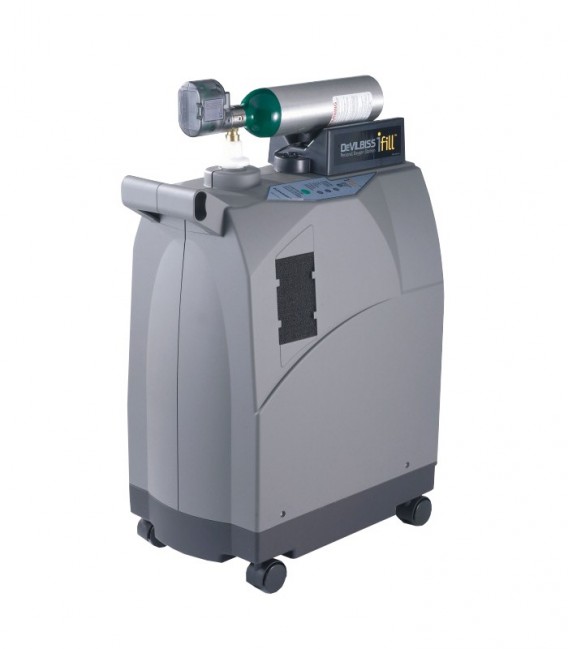OXYGEN CYLINDER FILLING STATION (Devilbiss iFill) 220V+ acc.
Valid Article
OXYGEN CYLINDER FILLING STATION (Devilbiss iFill)
Definition
A mains electricity (AC-powered) medical device used in filling or refilling ambulatory oxygen cylinders. Oxygen production is achieved by extracting the oxygen present in the ambient air to concentrate it to values > 90%, making it suitable for use in medical environments. This process therefore follows the same procedure as a standard oxygen concentrator. The oxygen thus produced is then pressurized to fill the oxygen cylinders.
The unit is supplied with 4 x 4.7 litre (or 4 x 2.9 litre in case of shortage) cylinders which is the minimum quantity for basic operations. However additional cylinders can be ordered.
Each 4.7-litre cylinder is pressurised to 150 bar, which results in a usable volume in each cylinder UV = Actual volume (4.7) X pressure in bar (138) = 650 litres of oxygen.
This autonomy allows us to operate a little less than one hour at 10 LPM of flow or about 5h30 at 2 LPM of flow.
This solution is therefore to be used only for TRANSPORT and is therefore not an interesting alternative to the fixed oxygen concentrator used in the hospital.
The filling time for a 4.7 litre bottle is approximately 6 hours.
Specifications
The iFill unit extracts purified oxygen from room air and pressurizes it to fill oxygen cylinders.
Quality standards
Components
The unit is delivered with
- 4 x 4.7 litre (or 2.9 litre) cylinders
- 1 x antibacterial filter - EEMDOCFS103
- 6 x dust filter - EEMDOCFS101
- 5 x long term filter - EEMDOCFS102
Technical specifications
- OXYGEN FILLING STATION
- Oxygen concentration: 93% ± 3%
- Power supply: 187-254V, 50-60 Hz
- Oxygen fill connector
- Oxygen fill connector cover/ Cylinder adaptor
- Cradle for oxygen cylinder
- Indicator panel with different lights
- Service required = red LED
- Standby = green light
- Full = green light
- Filling = green LED
- Instructions panel
- Air Filters
- 2 dust filters (one on each side)
- long term filter
- internal antibacterial filter
- Operating conditions
- temperature: 5º to 35ºC
- humidity range: 15 to 95% R.H. non-condensing
- Handles: rear and front
- OXYGEN CYLINDER
- with Continuous Flow Regulator (EU): 535-CF series
- Volume cylinder: 4.7 litres (or 2.9 litres)
- Average filling pressure: 138+/- 13.8 bar
- UV = usable volume cylinder = volume (4.7) X pressure in bar (138) = 650 litres of oxygen
- Autonomy: +/- 1 hour at 10 l/min or 5h30 at 2l/min
- Filling time: 6 hours / cylinder
Dimensions
- 31 x 57 x 72.5 cm (L x W x H)
- Weight: 30 kg
To be Ordered Separately
- Additional cylinders can be ordered: EEMDOCFA101/ EEMDOCFA103
- The trolley, EEMDOCFA102, is useful to easy the moving or to facilitate the moving of the 4.7 l cylinders inside the health structure and to help securing a cylinder vertically in a vehicle (strap the cylinder to the trolley, then the trolley to a fixed part of the vehicle)
Don't forget to order the administration devices in sufficient quantities because they are single patient use!
- oxygen masks for adults and children
- nasal oxygen cannula for adults and children
- nasal oxygen cannula for neo-nates and prematures
- oxygen tubes
Instructions for use
See user's manuel
- Set cylinder regulator to “Off”
- Remove cap from iFill unit
- Dock oxygen cylinder into oxygen fill connector, click in place
- Push Start/Stop button
- Filling is carried out autonomously and stops when the bottle is full.
- At the end of filling, depress the port collar, lift the cylinder. Replace the iFill protective cap.
- REFER TO YOUR SECTION'S GUIDELINE FOR THE SAFE STORAGE AND USE OF PRESSURIZED OXYGEN CYLINDERS.
Precautions for Use
- The station can only be used with iFill oxygen cylinders!
- The oxygen station should be at least 15 cm away from walls, draperies, or furniture to ensure sufficient airflow.
- Avoid placing the oxygen station next to heaters, radiators, or hot air registers. It should be kept at least 1.6m away from hot, sparking objects or naked sources of flame.
- Do not use in a closet.
- Do not use in an area where the air may be contaminated with carbon monoxide as this may shorten the life of the unit (i.e. near running gasoline engines, furnace, or heater).
- Never use the unit without a dust filter.
- Always secure cylinders in stock and cylinders used in services by making sure they are securely fastened to the wall.
MSF requirements
Oxygen cylinders are needed in the following situations:
- Patient transport, between service or in vehicles
- Where output pressures >20 PSI are needed, for example running some ventilator models.
- As back-up oxygen supply in an Operating Theatre for instance when there is a break-down of the oxygen concentrator.
Four oxygen cylinders in the standard composition allow to have two cylinders operational while the two other cylinders are filled again.





![[KMEDKHIE2CO] ICU, PART medical equipment, 4 beds/2 months, complete](/web/image/product.template/574421/image_256/%5BKMEDKHIE2CO%5D%20ICU%2C%20PART%20medical%20equipment%2C%204%20beds-2%20months%2C%20complete?unique=7d39917)
![[EEMDOCFA101] (station DeVilbiss iFill) CYLINDER O2 4.7L 535I-E-CF](/web/image/product.template/571568/image_256/%5BEEMDOCFA101%5D%20%28station%20DeVilbiss%20iFill%29%20CYLINDER%20O2%204.7L%20535I-E-CF?unique=f9a283f)
![[EEMDOCFA102] (station DeVilbiss iFill) TROLLEY for bottle](/web/image/product.template/570930/image_256/%5BEEMDOCFA102%5D%20%28station%20DeVilbiss%20iFill%29%20TROLLEY%20for%20bottle?unique=8f58f6b)
![[EEMDOCFA103] (station DeVilbiss iFill) CYLINDER O2 2.9L 535I-D-CF](/web/image/product.template/579797/image_256/%5BEEMDOCFA103%5D%20%28station%20DeVilbiss%20iFill%29%20CYLINDER%20O2%202.9L%20535I-D-CF?unique=3e9ccd5)
![[EEMDOCFS101] (station DeVilbiss iFill) FILTER DUST, 535D-605](/web/image/product.template/571567/image_256/%5BEEMDOCFS101%5D%20%28station%20DeVilbiss%20iFill%29%20FILTER%20DUST%2C%20535D-605?unique=e2699df)
![[EEMDOCFS102] (station DeVilbiss iFill) LONG TIME FILTER 515DZ-605](/web/image/product.template/571393/image_256/%5BEEMDOCFS102%5D%20%28station%20DeVilbiss%20iFill%29%20LONG%20TIME%20FILTER%20515DZ-605?unique=84c9556)
![[EEMDOCFS103] (station DeVilbiss iFill) ANTIBACT. FILTER 535D-615](/web/image/product.template/571392/image_256/%5BEEMDOCFS103%5D%20%28station%20DeVilbiss%20iFill%29%20ANTIBACT.%20FILTER%20535D-615?unique=4f59008)
![[EEMDOCFS104] (station DeVilbiss iFill) SIEVE BED, pair, 501DZ-619](/web/image/product.template/570496/image_256/%5BEEMDOCFS104%5D%20%28station%20DeVilbiss%20iFill%29%20SIEVE%20BED%2C%20pair%2C%20501DZ-619?unique=f4b40de)
![[EEMDOCFS105] (station DeVilbiss iFill) MAIN PC BOARD, 535D-622](/web/image/product.template/570221/image_256/%5BEEMDOCFS105%5D%20%28station%20DeVilbiss%20iFill%29%20MAIN%20PC%20BOARD%2C%20535D-622?unique=1e5748e)
![[EEMDOCFS106] (station DeVilbiss iFill) BOOSTER 535I-628](/web/image/product.template/570211/image_256/%5BEEMDOCFS106%5D%20%28station%20DeVilbiss%20iFill%29%20BOOSTER%20535I-628?unique=33cd577)
![[EEMDOCFS107] (station DeVilbiss iFill) COMPRESSOR 535I-604](/web/image/product.template/570213/image_256/%5BEEMDOCFS107%5D%20%28station%20DeVilbiss%20iFill%29%20COMPRESSOR%20535I-604?unique=1e5748e)
![[EEMDOCFS108] (station DeVilbiss iFill) 3-WAYS VALVE 535D-631](/web/image/product.template/575943/image_256/%5BEEMDOCFS108%5D%20%28station%20DeVilbiss%20iFill%29%203-WAYS%20VALVE%20535D-631?unique=e5e197d)
![[EEMDOCFS110] (station DeVilbiss iFill) DISTRIBUTOR 4/2, 535D-629](/web/image/product.template/578898/image_256/%5BEEMDOCFS110%5D%20%28station%20DeVilbiss%20iFill%29%20DISTRIBUTOR%204-2%2C%20535D-629?unique=3942f83)
![[EEMDOCFS111] (station DeVilbiss iFill) ROTATING VALVE, 535D-630](/web/image/product.template/578899/image_256/%5BEEMDOCFS111%5D%20%28station%20DeVilbiss%20iFill%29%20ROTATING%20VALVE%2C%20535D-630?unique=08e2bd4)
![[EEMDOCFS112] (station DeVilbiss iFill) DC POWER SUPPLY PC BOARD 535D-621](/web/image/product.template/582070/image_256/%5BEEMDOCFS112%5D%20%28station%20DeVilbiss%20iFill%29%20DC%20POWER%20SUPPLY%20PC%20BOARD%20535D-621?unique=71b1cd0)
![[KPROMPOSUA06X] MODULE UPS double convers. (Delta RT EXTEND.) 6kVA, 1ph/1ph](/web/image/product.template/577879/image_256/%5BKPROMPOSUA06X%5D%20MODULE%20UPS%20double%20convers.%20%28Delta%20RT%20EXTEND.%29%206kVA%2C%201ph-1ph?unique=df96342)
![[SCTDCANN2A-] NASAL OXYGEN CANNULA, 2 prongs + tube, adult](/web/image/product.template/571896/image_256/%5BSCTDCANN2A-%5D%20NASAL%20OXYGEN%20CANNULA%2C%202%20prongs%20%2B%20tube%2C%20adult?unique=c579a0c)
![[SCTDCANN2CL] NASAL OXYGEN CANNULA, 2 prongs + tube, child](/web/image/product.template/571930/image_256/%5BSCTDCANN2CL%5D%20NASAL%20OXYGEN%20CANNULA%2C%202%20prongs%20%2B%20tube%2C%20child?unique=c579a0c)
![[SCTDCANN2N-] NASAL OXYGEN CANNULA, 2 prongs + tube, neonate](/web/image/product.template/571935/image_256/%5BSCTDCANN2N-%5D%20NASAL%20OXYGEN%20CANNULA%2C%202%20prongs%20%2B%20tube%2C%20neonate?unique=a708924)
![[SCTDCANN2PL] NASAL OXYGEN CANNULA, 2 prongs + tube, premature](/web/image/product.template/571931/image_256/%5BSCTDCANN2PL%5D%20NASAL%20OXYGEN%20CANNULA%2C%202%20prongs%20%2B%20tube%2C%20premature?unique=2651d88)
![[SCTDMASO1A-] OXYGEN FACE MASK, simple, with tubing, adult size](/web/image/product.template/572292/image_256/%5BSCTDMASO1A-%5D%20OXYGEN%20FACE%20MASK%2C%20simple%2C%20with%20tubing%2C%20adult%20size?unique=bede3c8)
![[SCTDMASO1P-] OXYGEN FACE MASK, simple, with tubing, paediatric size](/web/image/product.template/572294/image_256/%5BSCTDMASO1P-%5D%20OXYGEN%20FACE%20MASK%2C%20simple%2C%20with%20tubing%2C%20paediatric%20size?unique=df29fb2)
![[SCTDTUOX10-] TUBE, OXYGEN, conical tip, 40 cm, s.u., CH 10](/web/image/product.template/572742/image_256/%5BSCTDTUOX10-%5D%20TUBE%2C%20OXYGEN%2C%20conical%20tip%2C%2040%20cm%2C%20s.u.%2C%20CH%2010?unique=30fcfdb)